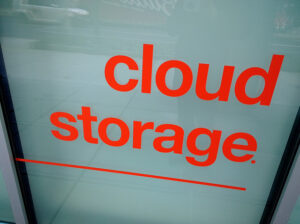Goods, Services and the Cloud

On its surface, the cloud is a relatively simple idea…except where sales taxes are concerned. Individuals and businesses use the cloud to access programs or store data via the Internet. There is usually no tangible property or service you can physically hold, nor can these materials be downloaded. However, you can often use them as you would previously have used the tangible version (i.e. digital music vs. a CD or software off the shelf vs. software as a service (“SaaS”) and that's where this issue gets complicated. The cloud challenges standard definitions of property and raises serious questions about taxation, both for sales tax and income tax.
Good or Service?
Say you purchase the use of “software” from a cloud provider for use in your business. Does it count as a tangible good even though the traditional rules don't apply? A key component of personal property is whether or not the item can be touched or otherwise “perceived by the senses.” For instance, a house is real estate, a car is personal property. These are important distinctions because classification determines what kinds of taxes apply. The water only gets muddier when you consider how the software is accessed. Chances are your business uses some form of cloud hosting service. Does this make the good a service? This is an argument that will need to be addressed as more and companies move toward cloud commerce. Read more
Focus on Oregon - Taxes and Tax Credits
Miles Consulting continues to help clients in many states, so this week we dedicate some blog time to Oregon. (Photo credit - M. Miles at Mulnomah Falls, OR.)
Business Climate:
Oregon is one of the few states without sales or use tax. However, they make up for it by being the third highest in the nation for personal income taxes. Yet, Oregon ranks 12 out of 50 states with the most favorable tax climate. The unemployment rate in Oregon was 6.9 percent in March compared to the national rate at 6.7 percent. Major Oregon industries include advanced manufacturing, clean technology, forestry/wood products, high technology, outdoor gear and activewear. (Oregon is home to Nike, Columbia Sportswear, and Adidas)
Oregon has one of the most aggressive renewable energy policies in the nation. The state’s standard requires that electric utilities must meet at least 25% of their Oregon load with renewable energy by the year 2025. Virtually all of Oregon’s electric load growth must come from new renewable energy. The standard also provides a goal that at least 1/3 of these targets be met by resources smaller than 25 megawatts in size. Solar energy counts double towards meeting the targets.
Taxes:
Oregon is one of just five states without a sales or use tax. (The other states are Alaska, Montana, New Hampshire, and Delaware.) Personal income tax rates in Oregon range from 5 percent to 9.9 percent. In comparison, New York ranges from 1 to 8.82 percent and; California ranges 1 to 13.3 percent. Oregon collects a corporate income/excise tax of 6.600 to 7.600 percent based on gross taxable income.Read more
Internet Tax Freedom Act: Why it's Important
An interesting debate is playing out in our nation's capital. The House of Representatives recently passed an extension of the Internet Tax Freedom Act. The legislation prohibits federal, state or local governments from taxing Internet access. Congress first passed the Internet Tax Freedom Act in 1998. Renewing or perhaps permanently banning taxes on Internet access is a smart idea. Well, things aren't as easy as they seem and to understand why we'll have to revisit the currently stalled Marketplace Fairness Act.
The Marketplace Fairness Act
As you may remember from our previous blog posts, the Marketplace Fairness Act would require most online vendors to collect sales tax. Currently, a company only has to charge sales tax if they have nexus in a particular state. The act would theoretically level the playing field between online retailers and traditional brick and mortar operations. Proponents also like the bill because it would bring more money into local coffers. But many of us, Miles Consulting Group included, think it’s not that simple, and that the Marketplace Fairness Act as proposed may create more problems than it solves.
A Tale of Two Acts
Here's where things get tricky. The Marketplace Fairness Act faces an uphill battle in the Republican controlled House, which is part of the reason it's currently stalled. The Internet Tax Freedom Act is now in the Senate and many believe it will be used as a bargaining chip. This is an election year and no incumbent wants to be seen letting a tax exemption expire that benefits his or her constituents. A tax on Internet connections would no doubt be passed along to consumers in the form of higher prices.
On the other hand, the Marketplace Fairness Act extends the realm of sales tax - you can probably see where this is going. Tax, of course, , is a dirty word in politics. This kind of narrow thinking will only impede progress and ensure nothing gets done. Most people would agree that our tax code is in need of reform. The Internet Tax Freedom Act and the Marketplace Freedom Act are useful pieces of legislation that should be considered individually.
In my opinion, the Senate should not hold the Internet Tax Freedom Act hostage while the House continues to mull over the Marketplace Fairness Act. The former is more of a “slam dunk” while the latter requires more discussion. Stay tuned for further updates on both pieces of legislation. We’ll be following them!
California Taxes are like the World Cup
As the soccer World Cup began this week, attracting the attention of the United States (and of course, the rest of the world), I reflected on my own childhood – watching soccer with my family. Not just any soccer, but German “Bundesliga” soccer. We cheered for FC Kaiserslautern and I also grew up following the German National Team in their quest for World Cups (3 so far). Of course, now that the United States team is also a contender, I watched with pride as both Germany and the US won their opening matches. I thought...World Cup soccer and CA tax policies have some commonalities. That might make an interesting blog.
Upsets occur...Some winners, some losers
An upset can certainly happen in soccer. Sometimes in the blink of an eye – there’s a lucky bounce or well directed header; sometimes a bad call by the referee, or sometimes just a crazy upset when you least expect it. On the World Cup stage, players are representing their whole country and there is a great deal of passion in both a win and a loss.
In California tax policy, we too have winners and losers, and passion on various sides of an issue. If you follow this blog, you know that our clients (and clients across the state) were dealt a huge blow last year when the Governor and state legislature decided to end the 20+ year enterprise zone program – literally in a vote that happened overnight. Almost a year later, people still ask me every day – “Why did they do away with a program that helped companies that were hiring people?” The answer, of course, is complicated – like that call in soccer as to whether the referee should pull out that red card on the player or not!
In place of the enterprise zone benefits, some new benefits have taken shape. There is the California Competes Tax Credit and the California Manufacturers’ Exemption for sales tax. The California Competes Tax Credit is for companies entering or expanding within California. A certain amount of money is allocated annually. There are myriad selection criteria and companies will have to prove their worthiness to even be considered. There will be winners…and losers. (Click here for more) The California Manufacturers’ Exemption for sales tax is an exemption for a portion of the state sales tax for companies in specific NAICS codes, placing into service qualifying machinery and equipment. It sounds straightforward, but there are nuances that will play out better for some companies than others. Not all industries qualify (some losers) and not all assets for even a qualified industry qualify (more losers), and it sunsets in 2021 (hurry up if you want to be a winner!). However, overall, we trust that it will be a good program that helps to put California on par with other states that have similar exemptions (a winner). (Click here for more)Read more
Taxes, Income and the Supreme Court

The United States Supreme Court has agreed to hear a case that has major tax implications. The central issue in Maryland State Comptroller v. Wayne is the extent to which states can tax income earned in another state by one of its residents. Maryland collects income tax at the state and county level. Residents are allowed to deduct income taxes paid to other states. However, the deduction doesn't apply to taxes collected by the county.
Brian and Karen Wynne held a stake in an S corporation which did business in 39 states. S corporations, like Limited Liability Companies and Partnerships, are pass-through entities which means income from the business can be applied to individual tax returns. Prior to deductions the Wynnes reported over $126,000 in Maryland state income tax. They claimed credits of more than $84,000 in taxes paid to other states. The Maryland Comptroller allowed the Wynnes to claim a credit from the state income tax but not the county.Read more
Focus on Texas
We’ve spent time recently blogging about changes in California. But, Miles Consulting also helps clients in other states , so we decided to dedicate some time on those as well. This week our focus is on Texas.
Business Climate:
Texas has long been considered a state that is friendly to business. Texas boasts that it is the state with the most exports – topping $279 Billion in 2013. It also lays claim to 52 of the Fortune 500 companies. http://www.texaswideopenforbusiness.com/business-climate/economic-strength.php Texas is a right to work state with low unionization, as well as low worker’s compensation rates. Major Texas industries include petroleum and natural gas, farming, steel, banking and tourism.
Taxes:
Texas is unique because the state does not impose a personal or corporate income tax, but instead relies on sales tax, property tax, and a franchise tax. The state’s current sales and use tax rate is 6.25%. In addition, cities, counties, special purpose districts, and transit authorities may also impose sales and use tax up to two percent for a total maximum combined rate of 8.25%. The franchise tax (also known as the “margin” tax) applies to partnerships (general, limited and limited liability), corporations, LLCs, business trusts, professional associations, business associations, joint ventures, incorporated political committees and other legal entities. If your annualized total revenue is less than or equal to $1,080,000, or your tax due is less than $1,000, you will owe no tax. All taxable entities must file a report, even if no tax is due. The following entities are not subject to the franchise tax: sole proprietorships and general partnerships directly and solely owned by natural persons. Read more
Introducing Miles Consulting Group

With this blog entry, I’m excited to announce Labhart Miles Consulting Group has been rebranded as Miles Consulting Group. We’ve launched a new website, and have a new logo design, as well as new company colors. Our ongoing dedication to high quality client service has not changed!
When Bill Labhart and I started Labhart Miles Consulting in 2002, our goal was to provide high quality, personalized service to a diverse client base. Over the last 12 years we’ve built a clientele that includes small businesses, technology companies, community banks, and Fortune 500 companies, among others. With the passage of time comes change and progress! Within the last year, Bill retired to spend more time with his family, we’ve dealt with some significant changes in the California tax credit program, and have witnessed increased discussion about the possibility of federal legislation that could change the multistate tax world as we all know it. I’m excited about the opportunities available during the next phase of the company!
The business name may have changed, but our level of commitment remains the same. We're excited to re-launch with a focus on four key areas: multi-state tax consulting, due diligence, credits and incentives and professional partnering.
Miles Consulting Group 4 Focus Areas:
Multi-State Tax Consulting
Does your business operate across state lines? If so, there are tax implications for both income tax and sales tax. Every state has its own set of tax laws and regulations. We can address a company’s multi-state tax issues before the auditor comes for a visit. We traditionally start with a nexus review to find out your level of exposure or compliance requirements. From there we can determine if your product or service is taxable for sales tax purposes and/or the proper apportionment of revenue for income tax purposes.
Due Diligence
As companies think about a merger, state tax due diligence can become an important part of the transaction analysis. Companies need to know what kinds of tax ramifications they might face ahead of time – not after the deal has been done. Proper due diligence (on either side of the transaction) can determine a target company's tax exposure and required level of compliance. These factors might not only shape the purchase price, they also impact your ongoing business related to bringing a target company into your company and systems. Remember, that a target company’s past history can continue to be your headache!
Credits and Incentives
For many years we specialized in the California Enterprise Zone Credit program. The state recently sunset that program in favor of three new incentives. We can assist your business in getting needed tax breaks both in California and in other states. States still offer a wide range of credits and incentives as they vie for businesses to locate (or stay) in their state. Among other things, your business may qualify for a hiring or investment credit or might be eligible for employee training reimbursement.
Professional Partnering
As state tax consultants, we are in a relationship business, working with our clients to get to the best overall answer for each situation. Many of our clients come to us by referrals from other professionals. And we, in turn, also refer our clients to our business partners. Oftentimes we receive referrals from CPAs, bookkeepers or attorneys who have valuable insight into particular facts or transactions, and have a unique history that can only benefit the client.
These are the core focus areas of Miles Consulting Group. Our experience with multi-state taxes, due diligence, credits and incentives and professional partnering make us a valuable resource for your business. You can find out more about our services by visiting the services area of our website.
We look forward to working with you!
Photo Credit: Crystal via Flickr
California's New Hiring Credit
In July of 2013, Governor Jerry Brown signed bills AB93 and SB90 which eliminated the former Enterprise Zone Hiring Credit and replaced it with the “California New Employment Credit” as of 1/1/14. The new 35% credit may sound good since an employee could generate up to $56,000 over a five year period (as opposed to the EZ at approximately $38,000 over a five year period), however, the New Employment Credit is much harder to qualify for and requires the employer to jump through many hoops in addition to burdensome documentation.
An eligible business must meet all the following requirements:
- Be located within a Designated Geographic Area (“DGA”). These areas are determined by the CA Department of Finance. The new designated areas will include the old Enterprise Zones, plus other specified census areas encompassing the state’s highest unemployment areas
- Be in an industry including: Manufacturing, Biomedical, Aerospace, and technology sectors, among others.
- Have a “net increase in number of jobs” over a base year.
The following are not eligible for the program: Retailers, food service, temporary employment agencies, casinos, bars, and sexually-oriented businesses. Note that small business (revenue less than $2million) can qualify for the New Employment Credit even within these industries (with the exception of sexually-oriented businesses).Read more
Sales Tax, Use Tax and the Marketplace Fairness Act
Sales tax has been in the news quite a bit lately. In previous posts I talked about the Marketplace Fairness Act. This proposed legislation would allow states more ability to collect sales tax from online retailers. Normally, a business can only collect sales tax if it has a presence in that state. The complementary use tax works to bridge that gap. Understanding the difference between the two taxes is important to understanding the current debate in Congress.
Use Tax Explained
There are two major components of a use tax. The first is that you or your business purchased an item (perhaps on-line from a vendor with no nexus in your state) without paying your home state's sales tax. Second, you intend to use, give away, store or consume that item in your home state. The use tax is complementary to the sales tax, and therefore the rate is the same as the residing state's sales tax. 45 states currently have a use tax. Businesses are generally able to report and remit the tax monthly or annually by filing a sales/use tax return. However, most individuals avoid paying the use tax because states rely on self-reporting. Herein lies most of the uncollected tax that states are so desperately seeking to collect.Read more
Coming Soon - CA Manufacturing Exemption
Those of you familiar with the old Manufacturers’ Investment Tax Credit may find the new California Manufacturing Exemption to be strikingly similar – but note that this version is a sales tax exemption versus a tax credit. The exemption reads much like the old statute and regulations under the Manufacturers’ Investment Tax Credit (“MIC”), which was a benefit from 1995 to 2003. (Yes – we’ve been around that long!) This new sales tax exemption is one of the three prongs of benefits that replaced the lucrative Enterprise Zone credits and deductions. For those of you not familiar with either incentive, we will give a brief overview of the new exemption this week.
The California Manufacturing Exemption begins July 1, 2014 and allows certain manufacturing and biotech companies to exempt from sales and use tax purchases of manufacturing and research and development (R&D) equipment. Purchased equipment or machinery must be used 50% or more during the manufacturing process. Equipment and machinery purchased and used for R&D qualifies as well. In any given calendar year, the combined amount of purchase must not exceed $200 million dollars. Any purchases beyond the $200 million threshold will not qualify. In addition, only part of the state tax portion of the sales tax is exempt. The exemption amounts to 4.1875% of the purchase price of qualified property. Since the exemption is partial, recordkeeping will be key!Read more




















